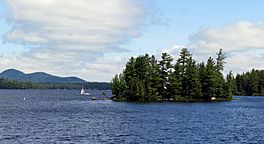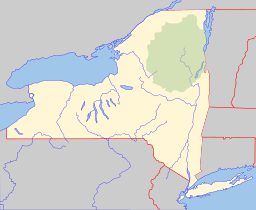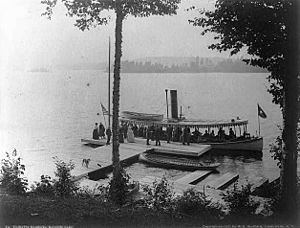Raquette Lake facts for kids
Quick facts for kids Raquette Lake |
|
|---|---|

Looking north at Strawberry Island on Raquette Lake from the southwestern corner
|
|
| Location | Adirondack Mountains, Hamilton County, New York, United States |
| Coordinates | 43°50′N 74°39′W / 43.833°N 74.650°W |
| Type | Lake |
| Primary inflows | Marion River, Browns Tract Inlet, Death Brook, Boulder Brook, Sucker Brook, South Inlet |
| Primary outflows | Raquette River |
| Basin countries | United States |
| Surface area | 4,925 acres (19.93 km2) |
| Average depth | 44 feet (13 m) |
| Max. depth | 95 feet (29 m) |
| Shore length1 | 99 miles (159 km) |
| Surface elevation | 1,762 feet (537 m) |
| Islands | Harding Island Big Island Inman Island Osprey Island Hen and Chicken Islands Beecher Island St. Hubert Island Strawberry Island Needle Island |
| 1 Shore length is not a well-defined measure. | |
Raquette Lake is a beautiful lake located in the Adirondack Mountains of New York State. It is the starting point, or source, of the Raquette River. The lake is close to the small town also called Raquette Lake, New York.
This lake has about 99 miles (159 kilometers) of shoreline, surrounded by tall pine trees and mountains. It is found in two towns, Long Lake and Arietta, both in Hamilton County.
Raquette Lake is a very popular spot, especially during the summer. People love visiting for the amazing scenery, the chance to see wildlife, and for fun activities like boating and hiking. There are even summer camps for kids, such as Raquette Lake Boys Camp and Raquette Lake Girls Camp. In winter, the area gets a lot of snow, making it great for snowmobiling, cross-country skiing, and snowshoeing. The lake is also part of the 740-mile (1,190 km) Northern Forest Canoe Trail, which starts in Old Forge, New York, and ends in Fort Kent, Maine.
Contents
History of Raquette Lake
How did Raquette Lake get its name?
No one is completely sure how Raquette Lake got its name. One story says it was named after snowshoes. In French, a snowshoe is called a raquette. The story goes that in 1776, a group of people called Tories were traveling by snowshoe with their leader, Sir John Johnson, 2nd Baronet. When they reached the lake, the weather suddenly got warmer, and the snow started to melt. They left all their snowshoes together on the shore, and that's how the lake supposedly got its name.
The "Great Camps" Era
In the 1800s, Raquette Lake became a very fancy summer getaway for wealthy families. In 1877, a man named William West Durant began building what would become the first of the famous "Great Camps" – Pine Knot. These were huge, luxurious summer homes built in a special style using natural materials from the Adirondacks.
Other "Great Camps" on Raquette Lake include North Point, which was rebuilt in 1903, Echo Camp (built in 1883), and Bluff Point (built in 1876). Raquette Lake was also a central point for visiting other "Great Camps" nearby, like Sagamore (built in 1897), Camp Uncas (built in 1890), and Kamp Kill Kare (built in 1896). Today, Sagamore is a National Historic Landmark and is open to the public for tours and educational programs.
Important "Great Camps" on Raquette Lake
Bluff Point: A Private Retreat
Bluff Point is still a private camp today, and it operates much like it did over 100 years ago. It was built by Francis Stott, who was suggested to build it by Dr. Thomas C. Durant. When Bluff Point was sold to a magazine publisher named Robert Collier in 1905, many of the original buildings were changed and made bigger. This is when features like the huge walk-in fireplace and the bowling alley were added.
Pine Knot: A Showcase Camp
William West Durant, the son of Thomas C. Durant, designed Pine Knot, Uncas, and Sagamore. His father, Thomas C. Durant, was famous for building the eastern part of the Transcontinental Railroad. William took over the building of Camp Pine Knot in 1879, and construction continued until 1890. This beautiful camp was used by William West Durant to show off his building skills. He would invite important railroad owners to stay there, hoping they would hire him to build similar camps for them.
In 1895, William West Durant sold Camp Pine Knot to Collis P. Huntington, who built the western part of the Transcontinental Railroad. This sale helped William pay off a debt. Later, in 1949, Archer Huntington gave the camp to SUNY Cortland to be used for education. The Huntington family also donated the land for the Raquette Lake Chapel in the village in 1938.
William West Durant also helped pay for two summer churches on Raquette Lake that could only be reached by boat. These were the Church of the Good Shepherd (built in 1880) and St. William's Catholic Church on Long Point (built in 1890). Both churches were designed by a New York City architect named J. Cleaveland Cady.






